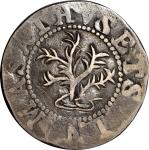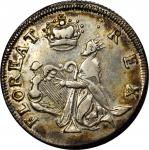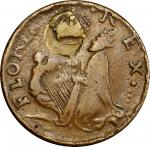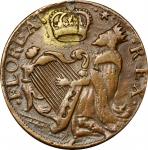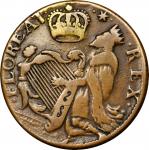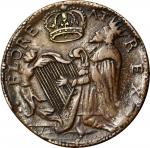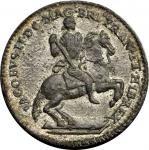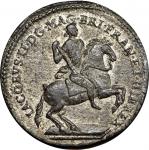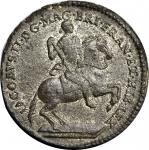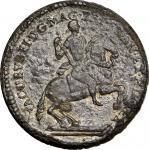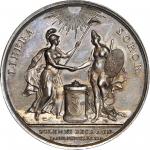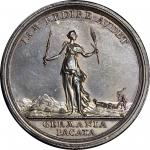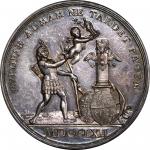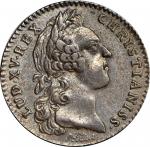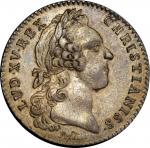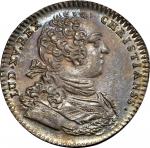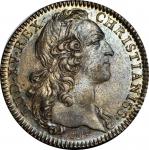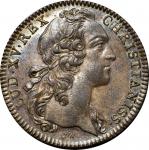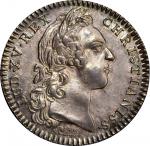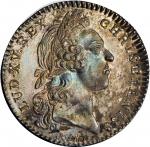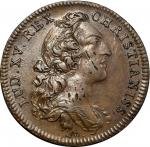1783 Felicitas Britannia et America Medal. Betts-614. Pewter or Tin. Twin-Leaf Edge Device. EF Details--Damage (PCGS).Twin-leaf edge device. 345.9 grains. 39.1 mm. 2.7 - 2.9 mm thick. 135 degrees counterclockwise from medal turn. One of the outstanding historical rarities among medals of the Revolutionary War, now easily seen in a new context with recent revelations about the true nature of Continental dollars. Glossy deep gray, not quite black but darker than slate, with mostly smooth surfaces. A few raised areas of tinpest are seen on the reverse, but none are present on the obverse; the largest is at the junction of the Maryland and Virginia rings below WE ARE ONE. Some pest and subtle crumbling is seen at the edges, not unusual for the issue. Two large digs, below BR and the first N of BRITANNIA, are the most notable obverse defects, joining a few light scratches in the upper left and upper central fields. A couple of somewhat heavier scratches are present right of center near the base of the reverse. The sharpness puts this piece in the top flight of non-Mint State examples of this rarity, as most of those showing handling are far scruffier than this.<p>By any accounting, this is one of the most important of all Revolutionary War medals, a crude foil to the elegance of the Libertas Americana medal, juxtaposed with consecutive numbers in Betts and struck within months of each other. While the Libertas Americana medals story is told with reams of original documentation, letters from Benjamin Franklin, sketches and models and more, the story of the Felicitas Britannia et America medal is a numismatic pantomime, silent but expressive, with no evidence more than the medals themselves. The obverse is suggestive: a London skyscape, prominently including St. Pauls Cathedral; crude renditions of a standing goddess America and the seated Britannia, the latter reminiscent of some of the crudest base metal medalets of George IIIs reign; an exergual date of one day after the finalizing of the Treaty of Paris; and a reverse that is an exact copy of the Continental "dollar," clearly rendered by the same hand and struck in the same composition, all finished with an edge device that is essentially identical to that seen on the Continental dollars.<p>For decades, numismatists (including this cataloger) tried to explain away the obvious: that a medal depicting Londons skyline must have been an English medal, but is somehow just like the evidently American Continental "dollar." The well-documented research that proved the Continental "dollars" were actually English medals struck ca. 1783 makes this medal far more easy to understand. That the two pieces came from the same shop now seems obvious; that it was made in England for an audience that clamored for anything having to do with the exciting new nation across the Atlantic seems no less evident. Such as most Continental dollars have provenances that lead back to England, so too does the Betts-614. The principal difference between this medal and the Continental dollar, beyond the cosmetic, is this medal is at least an order of magnitude rarer.<p>Somewhere in the range of 15 specimens survive. Most are not very attractive, and a substantial proportion have partial drillholes on them. Few are fully Mint State. This specimen is among the most famous, as the Garrett Collections inclusion of this medal with their Continental dollars set a trend that was more appropriate than most realized. The Norwebs and John J. Ford, Jr. did the same. There was only one in the John Ford collection, sold in our Ford I sale of 2003 along with his Continental dollars. Eric Newman owned one, a low grade piece formerly from Col. E.H.R. Green, also sold with his Continental dollars. Others have graced the cabinets of Lucien LaRiviere, Mrs. Norweb (the same piece brought over $88,000 in the recent Partrick sale), and John Work Garrett. The C.W. Betts piece is in the collection at Yale, the Charles P. Senter example is in the American Numismatic Society, the LaRiviere medal is now at Colonial Williamsburg, and the Boyd duplicate (ex Bowers and Ruddys Scott sale of 1975) is at Mount Vernon. Along with the example in the British Museum, no fewer than five examples are impounded, perhaps a third of the entire population. Many, even most, are low grade, indicating that this medal was intended for popular consumption, not for the cabinets of the upper class. This low-priced tin medal deserves a place along its more famous (and more common) kin in any well-formed early American cabinet.From the E Pluribus Unum Collection. Earlier from our (Bowers and Ruddys) sale of the Garrett Collection for the Johns Hopkins University, Part III, October 1980, lot 1494.


